
Drosera pedicellaris is a pygmy species of the sundew genus (Drosera). It was discovered in 1997 and described in 2002 by Allen Lowrie. It is endemic to Western Australia.
The genus Drosera was divided in 1994 by Seine & Barthlott into three subgenera and 11 sections on the basis of morphological characteristics.

Drosera callistos is a species of pygmy sundew from Western Australia. The specific epithet callistos is from the Greek word callistos meaning beautiful.
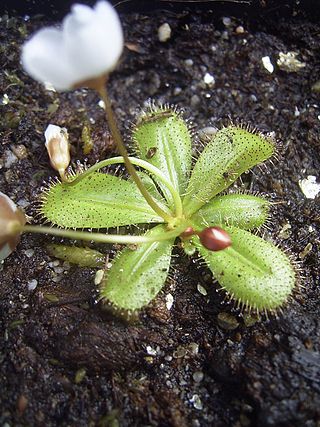
Drosera tubaestylis is a perennial tuberous species in the genus Drosera that is endemic to Western Australia. It grows in a rosette about 2 to 3 cm in diameter. It is native to an area near Perth. It grows in fine sandy clay soils at the margins of swamps. It is considered to be related to D. bulbosa. The species is named for the trumpet-shaped style apices. It was first formally described by Allen Lowrie and N. G. Marchant in 1992.
Drosera orbiculata is a perennial tuberous species in the genus Drosera that is endemic to Western Australia. It grows in a rosette about 1.5 cm in diameter. It is native to an area 1.3 km north of Gillingarra near Perth. It grows in sandy clay soils in winter-wet depressions and washes. It is considered to be related to D. rosulata. The species is named for the shape of the leaf lamina. It was first formally described by Allen Lowrie and N. G. Marchant in 1992.
Drosera lowriei is a perennial tuberous species in the genus Drosera that is endemic to Western Australia. It grows in a rosette about 3 cm in diameter. It is native to an area northwest of Esperance. It grows in loam soils in wet zones near granite outcrops. It is considered to be related to D. zonaria. It was first formally described by N. G. Marchant in 1992 and named in honour of Allen Lowrie.
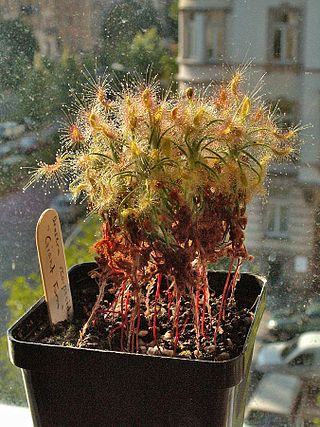
Drosera scorpioides, commonly called the shaggy sundew, is a pygmy sundew native to the Jarrah Forest region and southern coasts of Southwest Australia. Notable for its unusually large size relative to other pygmy sundews, D. scorpioides can produce rosettes measuring up to two inches in diameter and specimens may attain a height of up to 100 millimeters. The species is found on white sand and clay, near swamps, on sand ridges, and is associated with laterite. The flowers are pink and white, appearing sometime between August and October. Depending on the form, D. scorpioides can be expected to live up to seven years.
Drosera marchantii is an erect perennial tuberous species in the carnivorous plant genus Drosera. It is endemic to Western Australia and grows in a variety of habitats, including swampy areas and hilltops in laterite-silica sand soils. D. marchantii produces small, circular, peltate carnivorous leaves along stiff stems that can be 10–40 cm (4–16 in) high. Its pink flowers emerge from June to October.

Drosera menziesii, the pink rainbow, is an erect or scrambling perennial tuberous species in the carnivorous plant genus Drosera. It is endemic to Western Australia and grows in a variety of habitats, including winter-wet depressions, swamps, and granite outcrops in clay or peat sand soils or loam. D. menziesii produces small, circular carnivorous leaves along an undulating erect stem that can be .05–1.1 m (0.2–3.6 ft) high. Its pink flowers emerge from July to November.
Drosera salina is an erect perennial tuberous species in the carnivorous plant genus Drosera. It is endemic to Western Australia and is only found in salt-free sand on the margins of salt lakes in a few locations north of Albany east to north-west of Esperance. The specific epithet, salina, refers to the salt lake margins that this species inhabits. D. salina produces small carnivorous leaves along stems that can be 7 cm (3 in) high. White flowers bloom from July to September.

Drosera meristocaulis is a perennial species in the carnivorous plant genus Drosera, the only member of the subgenus Meristocaulis. It is a small, rosette- and branched stem-forming sundew that has many morphological affinities to the Australian pygmy sundews. D. meristocaulis is wholly endemic to Pico da Neblina, an isolated mountain on the Brazil-Venezuela border.

Australia has one of the world's richest carnivorous plant floras, with around 187 recognised species from 6 genera.

Drosera barbigera is a species of pygmy sundew from Western Australia. The specific epithet "barbigera" is derived from Latin and means "bearded".
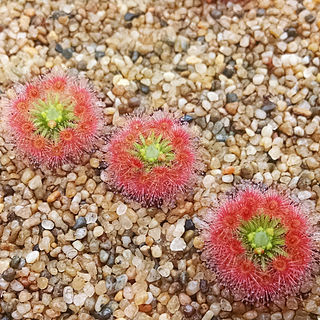
Drosera paleacea is a species of pygmy sundew from Western Australia.

Drosera sargentii is a species of pygmy sundew from Western Australia.
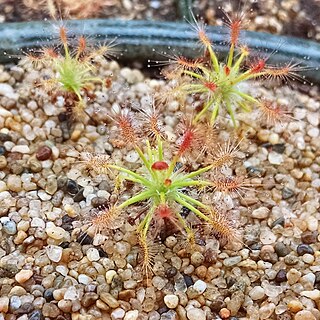
Drosera silvicola is a species of pygmy sundew from Western Australia. The specific epithet "silvicola" is derived from Latin, meaning "living in the forest", referring to the location of its habitat.
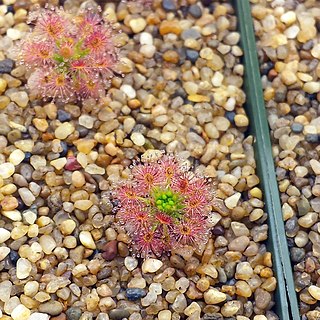
Drosera roseana is a species of pygmy sundew from Western Australia.
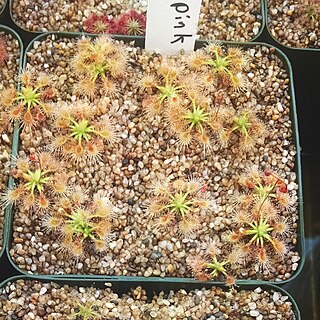
Drosera omissa is a species of pygmy sundew from Western Australia.
Drosera nivea is a species of carnivorous plant. It is a pygmy sundew and is native to Western Australia. The specific epithet nivea is derived from the Latin word niveus, meaning white, in reference to the colour of the plant's flower. It is closely related to Drosera citrina and has previously been considered a variety of D.citrina known as D. citrina var. nivea.
Drosera albonotata is a species of pygmy sundew native to Western Australia. It was first described by Alastair Robinson, Adam Cross, Manfred Meisterl and Andreas Fleischmann in 2018.














